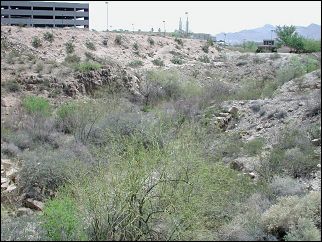
Palo verdes, the Spanish name referring to the attractive green trunks, are common trees in the Sonoran Desert. The Chihuahuan Desert lacks those species native to Arizona and Sonora, but Retama, also known as Palo Verde, has been making its way north. Possibly a native of South America, it now is widely naturalized and cultivated in the Southwestern states, apparently limited on the north by low winter temperatures preventing establishment of seedlings.
A thorned tree up to 40 feet tall, its attractive foliage filters the hot desert sun, throwing a diffuse shade that allows other plants to grow beneath it. Bright yellow flowers provide a showy display. Like other members of the bean family, it often harbors special bacteria in nodules on its roots. These microorganisms change nitrogen from the air to a form usable by plants, a real boon in the often nitrogen-deficient soils of the desert.
There is a drawback, however. Thorns and bags have an affinity to one
another during our spring windy season, accounting for a local name, the Plastic Bag
Tree.
![]()
Contributor: Arthur H. Harris, Laboratory for Environmental Biology, Centennial Museum, University of Texas at El Paso.
Desert Diary is a joint production of the Centennial Museum and KTEP National Public Radio at the University of Texas at El Paso.

University of Texas at El Paso campus. Several of the yellowish-green, naturalized Parkinsonia trees are strung out along the arroyo. The trees are not yet fully leafed out. The darker green trees are Siberian Elm, likewise naturalized. Photograph by A.H. Harris, 6 April 2002.